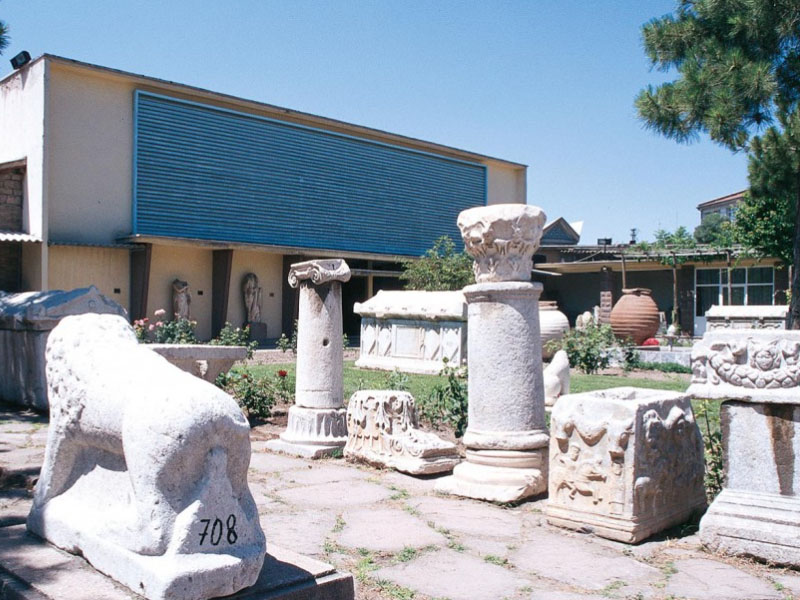Konya Archeology Museum, located in the Konya province of Türkiye, was first opened in 1901 in the building at the southwest corner of Karma Secondary School. In 1927, the artifacts were moved to the Mevlana Museum, and in 1953, to the İplikçi Mosque. The current building of the museum opened in 1962 in the Meram district.

Konya Archeology Museum (TR Ministry of Culture and Tourism)
Exhibited Artifacts and Periods
Numerous archaeological artifacts from the Neolithic Age, starting with the Early Bronze, Middle Bronze (Assyrian Trade Colonies), Iron Age (Phrygian, Urartian), Classical, Hellenistic, Roman, and Byzantine periods are exhibited in the Konya Archeology Museum. Most of these artifacts were obtained from important archaeological excavation sites such as Çatalhöyük, Erbaba, Süberde, Sızma, Karahöyük, Kıcıkışla, Sille, Çumra, Alibeyhöyük, Alaeddin Hill, and the surroundings of Lake Beyşehir.

Konya Archeology Museum (TR Ministry of Culture and Tourism)
Prehistoric Artifacts Hall
- Neolithic Age (6500-5300 BC): Arrow and spearheads made of obsidian and flint, and terracotta pots unearthed from Çatalhöyük, Erbaba, and Süberde excavations are exhibited.
- Early Bronze Age (3000-1950 BC): Terracotta pots from Sızma and Karahöyük excavations and grooved pots unique to the Lake Beyşehir region are included.
- Middle Bronze Age (1950-1750 BC): Wheel-made terracotta pots, bronze rings, cylinder seals, and oil lamps in the shape of grape clusters found in Karahöyük excavations are exhibited.
Iron Age Artifacts Hall
- Iron Age (8th-6th century BC): Vessel fragments from the Phrygian period found at Konya Alaeddin Hill, Phrygian and Lydian vessels from the Kıcıkışla region, and Urartian bronze fibulae are located in the museum.
- Classical Period (480-330 BC): Examples of imported kylixes, lekythoi, and oinochoes decorated with the black-figure technique brought from Kıcıkışla are exhibited.
- Hellenistic Period (330-30 BC): Brightly polished plates, bowls, and deeply carved vessel molds are included.
- Roman Period (30 BC- 395 AD): Among the bronze statuettes are figures of Hermes, Eros, and a bull.
Roman Period Hall
The Sidemara type columnar marble Sarcophagus of Herakles (250-260 AD), brought from Yunuslar Village in Beyşehir district, is among the significant artifacts.
Sidemara type columnar and Pamphylian type garlanded sarcophagi unearthed from the Iconium necropolis, a statue of Poseidon, terracotta sarcophagi, perfume vessels, glass tear bottles, gold jewelry, an ivory comb, and manicure tools are located in the museum.
Byzantine Period Artifacts
A large floor mosaic, found during excavations in Sille Tatköy in 1990 and dated to the 6th century AD, is exhibited.
Floor mosaics and artifacts such as bronze door knockers, crosses, and reliquaries unearthed from excavations at Çumra, Alibeyhöyük, and Kilise Mevkii are included.
Garden and Open-Air Artifacts
In the portico at the museum entrance, stone and marble architectural pieces from the Byzantine period, gravestones, and Roman period tomb steles are exhibited.
In the front garden, Roman period marble sculptures, sarcophagi, burial chests, tomb lions, column capitals, and inscriptions are located. Among the inscriptions are texts related to Iconium, Derbe, and Lystra, cities visited by Saint Paul.

Konya Archeology Museum (Konya Governorship)
Important Excavation Sites
Most of the artifacts were obtained from excavations in Konya and its surroundings. These include Çatalhöyük, Erbaba, Süberde, Sızma, Karahöyük, Kıcıkışla, Sille, Çumra, Alibeyhöyük, Alaeddin Hill, and the surroundings of Lake Beyşehir.
Location and Visit Information
The museum is located at the Sahibata District, Sahibata Street No. 91, Meram district, Konya. Visiting hours are from 09:00 in the morning until 17:00 in the evening, and the ticket office closes at 16:40. The museum is closed on Mondays.


